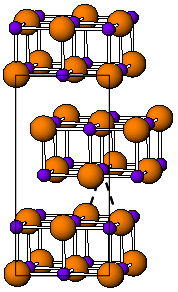Thallium(I) iodide

| |
| Names | |
|---|---|
| Other names
Thallium monoiodide
Thallous iodide | |
| Identifiers | |
3D model (
JSmol ) |
|
| ChemSpider | |
ECHA InfoCard
|
100.029.272 |
| EC Number |
|
PubChem CID
|
|
| UNII | |
CompTox Dashboard (EPA)
|
|
| |
| |
| Properties | |
| TlI | |
| Molar mass | 331.287 g/mol[1] |
| Appearance | yellow crystals[1] |
| Density | 7.1 g/cm3[1] |
| Melting point | 441.7 °C (827.1 °F; 714.8 K)[1] |
| Boiling point | 824 °C (1,515 °F; 1,097 K)[1] |
| 0.085 g/L (25 °C)[1] | |
| Solubility | insoluble in alcohol[1] |
| −82.2·10−6 cm3/mol[2] | |
| Hazards | |
| GHS labelling: | |
  
| |
| Danger | |
| H300, H330, H373, H411 | |
| P260, P264, P270, P271, P273, P284, P301+P310, P304+P340, P310, P314, P320, P321, P330, P391, P403+P233, P405, P501 | |
| Flash point | Non-flammable |
| Related compounds | |
Other anions
|
Thallium(I) fluoride Thallium(I) chloride Thallium(I) bromide |
Other cations
|
Gallium(I) iodide
Indium(I) iodide |
Related compounds
|
Mercury(II) iodide Lead(II) iodide |
Except where otherwise noted, data are given for materials in their standard state (at 25 °C [77 °F], 100 kPa).
| |
Thallium(I) iodide is a
.Chemistry
TlI can be formed in aqueous solution by metathesis of any soluble thallium salt with iodide ion. It is also formed as a by-product in thallium-promoted iodination of phenols with thallium(I) acetate.
Attempts to oxidise TlI to thallium(III) iodide fail, since oxidation produces thallium(I) triiodide, Tl+I3−.
Physical properties
The room temperature form of TlI is yellow and has an
Applications
Thallium(I) iodide was initially added to mercury arc lamps to improve their performance[7] The light produced was mainly in the blue green part of the visible light spectrum least absorbed by water, so these have been used for underwater lighting.[8] In modern times, it is added to quartz and ceramic metal halide lamps that uses rare-earth halides like dysprosium, to increase their efficiency and to get the light color more close to the blackbody locus. Thallium iodide alone can be used to produces green colored metal halide lamps. Thallium(I) iodide is also used in trace amounts with NaI or CsI to produce scintillators used in radiation detectors.
Natural occurrence
Natural thallium(I) iodide was first discovered in a naturally occurring setting in 2017 as a orthorhombic polymorph called nataliyamalikite. Small grains were found embedded in mascagnite sourced from fumaroles at Avachinsky, a volcano in Russia's Kamchatka Peninsula that can reach temperatures of 640 °C (1,184 °F). The geologists that discovered it speculate that further research into this mineral is likely to add to the understanding of the geochemical evolution of the planet[9][10]
Safety
Like all thallium compounds, thallium(I) iodide is highly toxic.
References
- ^ a b c d e f g Haynes, p. 4.94
- ^ Haynes, p. 4.136
- ^ .
- .
- .
- .
- .
- ^ Underwater Journal and information bulletin, IPC Science and Technology Press, (1973), p 245
- ^ "Nataliyamalikite: Mineral information, data and localities". www.mindat.org.
- ^ Anderson, Natali (July 6, 2017). "New Mineral Discovered: Nataliyamalikite". Sci News. Retrieved March 16, 2022.
Cited sources
- Haynes, William M., ed. (2011). ISBN 1-4398-5511-0.
